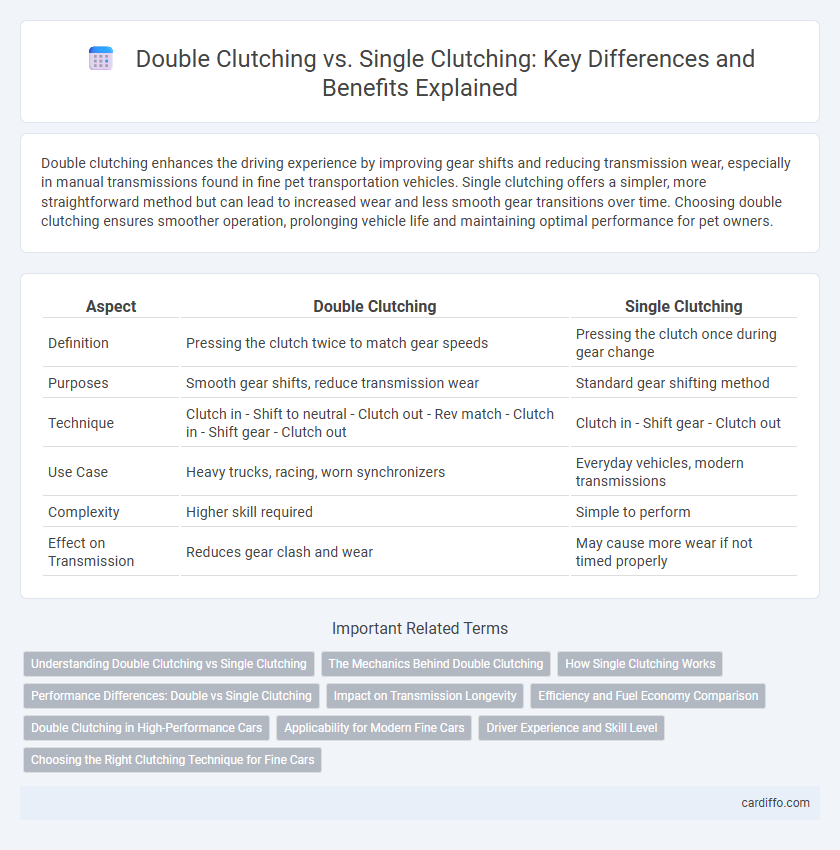Double clutching enhances the driving experience by improving gear shifts and reducing transmission wear, especially in manual transmissions found in fine pet transportation vehicles. Single clutching offers a simpler, more straightforward method but can lead to increased wear and less smooth gear transitions over time. Choosing double clutching ensures smoother operation, prolonging vehicle life and maintaining optimal performance for pet owners.
Table of Comparison
| Aspect | Double Clutching | Single Clutching |
|---|---|---|
| Definition | Pressing the clutch twice to match gear speeds | Pressing the clutch once during gear change |
| Purposes | Smooth gear shifts, reduce transmission wear | Standard gear shifting method |
| Technique | Clutch in - Shift to neutral - Clutch out - Rev match - Clutch in - Shift gear - Clutch out | Clutch in - Shift gear - Clutch out |
| Use Case | Heavy trucks, racing, worn synchronizers | Everyday vehicles, modern transmissions |
| Complexity | Higher skill required | Simple to perform |
| Effect on Transmission | Reduces gear clash and wear | May cause more wear if not timed properly |
Understanding Double Clutching vs Single Clutching
Double clutching involves shifting gears by pressing the clutch twice to match the engine speed with the transmission speed, enhancing smooth gear transitions and reducing wear on the clutch. Single clutching relies on one clutch press per gear shift, often causing more wear and less smoothness in older vehicles without synchronizers. Mastery of double clutching is crucial for driving heavy trucks or classic cars with unsynchronized manual transmissions.
The Mechanics Behind Double Clutching
Double clutching involves pressing the clutch pedal twice during gear changes to match engine speed with transmission speed, preventing gear grinding and wear. This technique requires disengaging the clutch, shifting to neutral while revving the engine to synchronize RPM, then re-engaging the clutch for the next gear. Single clutching only uses one clutch press per gear change, relying on transmission synchronizers to align speeds, which may cause more wear under high-performance or heavy-duty conditions.
How Single Clutching Works
Single clutching involves pressing the clutch pedal once to disengage the engine from the transmission for a gear change, then releasing it after the shift is complete. This technique requires synchronizing engine speed and gear speed without the intermediate step of rev-matching during the gear shift. Single clutching is commonly used in modern manual transmissions with synchronized gears to ensure smooth gear engagement.
Performance Differences: Double vs Single Clutching
Double clutching improves gear shift performance by synchronizing engine speed with transmission speed, reducing drivetrain wear and enabling smoother transitions, especially in older manual transmissions. Single clutching often results in harsher shifts due to mismatched speeds between engine and transmission, potentially causing gear grinding and increased wear. Performance gains with double clutching are most evident in heavy-duty or racing scenarios where precise gear engagement and longevity are critical.
Impact on Transmission Longevity
Double clutching reduces wear on transmission synchronizers by matching gear speeds, leading to smoother shifts and prolonged transmission lifespan. Single clutching can cause increased synchro wear due to speed mismatches, accelerating clutch and gearbox component degradation. Consistent use of double clutching minimizes transmission heat and mechanical stress, enhancing overall durability.
Efficiency and Fuel Economy Comparison
Double clutching improves gear transition smoothness by matching engine and transmission speeds, resulting in reduced drivetrain wear and enhanced fuel efficiency compared to single clutching. Single clutching often causes more friction and energy loss due to less precise synchronization, leading to slightly higher fuel consumption. Efficient gear shifts through double clutching contribute to better overall fuel economy, especially in older vehicles without synchronized gearboxes.
Double Clutching in High-Performance Cars
Double clutching in high-performance cars enhances gear synchronization by matching engine speed with transmission speed, reducing wear on the synchronizers and enabling smoother, faster shifts. This technique is especially beneficial during aggressive driving or racing, where precise control and durability are critical. Compared to single clutching, double clutching allows drivers to maintain optimal power delivery and minimizes drivetrain shock, improving overall vehicle performance.
Applicability for Modern Fine Cars
Double clutching enhances gear synchronization in manual transmissions, reducing wear and improving shift smoothness, particularly beneficial for vintage or heavy-duty vehicles. Modern fine cars predominantly use synchronized gearboxes or advanced dual-clutch systems, rendering single clutching more efficient and user-friendly for everyday driving. The applicability of double clutching in contemporary luxury or high-performance cars is limited, as electronic controls optimize shift timing without needing manual clutch modulation.
Driver Experience and Skill Level
Double clutching enhances driver experience by requiring precise timing and coordination, improving gear shifting smoothness especially in older or non-synchronized transmissions. Single clutching simplifies the process, being more accessible for drivers with basic skills and modern synchronized gearboxes. Mastery of double clutching reflects advanced driving skill, offering greater control and longevity of transmission components.
Choosing the Right Clutching Technique for Fine Cars
Choosing the right clutching technique for fine cars depends on the vehicle's transmission system and driving conditions. Double clutching improves gear synchronization in older or non-synchronized manual transmissions, reducing wear and enhancing smoothness, while single clutching suffices for modern synchronized gearboxes due to their built-in mechanisms. Understanding the clutch design and the car's handling characteristics ensures optimal performance and longevity.
Double clutching vs Single clutching Infographic

 cardiffo.com
cardiffo.com